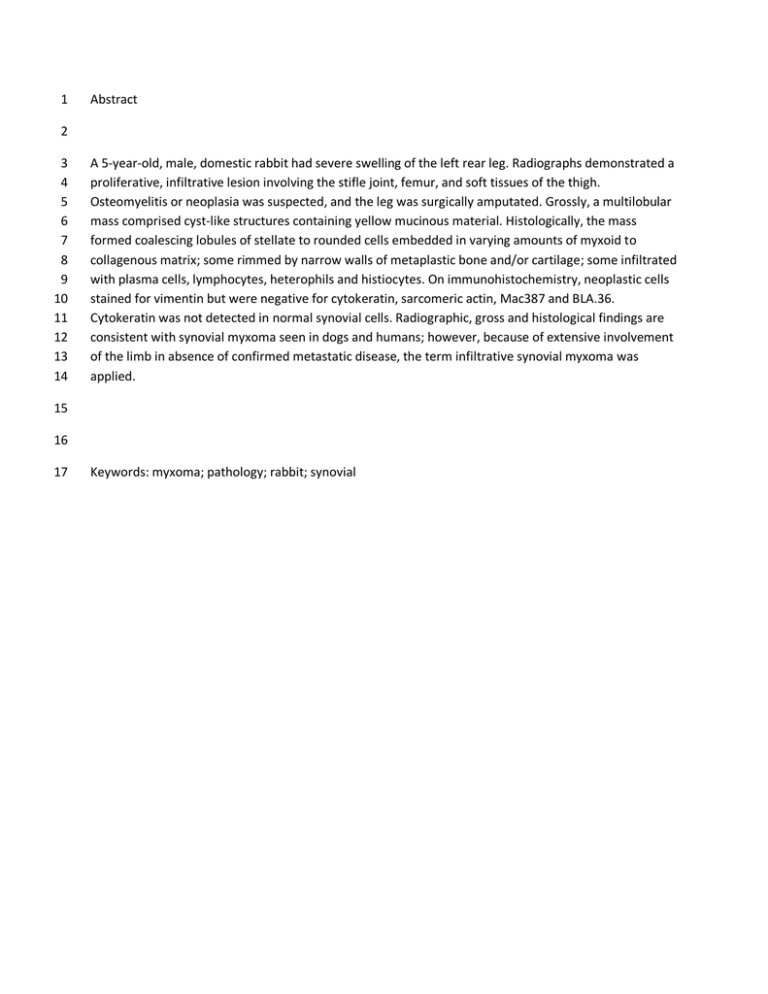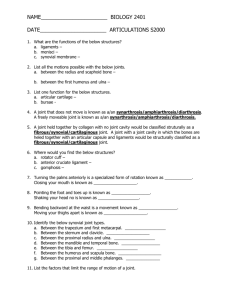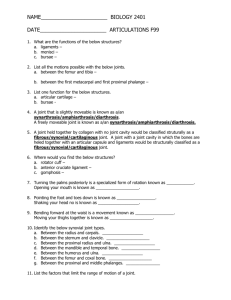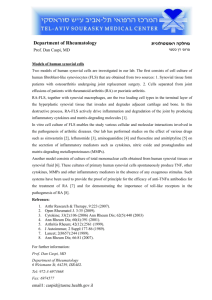Abstract 1 2
advertisement

1 Abstract 2 3 4 5 6 7 8 9 10 11 12 13 14 A 5-year-old, male, domestic rabbit had severe swelling of the left rear leg. Radiographs demonstrated a proliferative, infiltrative lesion involving the stifle joint, femur, and soft tissues of the thigh. Osteomyelitis or neoplasia was suspected, and the leg was surgically amputated. Grossly, a multilobular mass comprised cyst-like structures containing yellow mucinous material. Histologically, the mass formed coalescing lobules of stellate to rounded cells embedded in varying amounts of myxoid to collagenous matrix; some rimmed by narrow walls of metaplastic bone and/or cartilage; some infiltrated with plasma cells, lymphocytes, heterophils and histiocytes. On immunohistochemistry, neoplastic cells stained for vimentin but were negative for cytokeratin, sarcomeric actin, Mac387 and BLA.36. Cytokeratin was not detected in normal synovial cells. Radiographic, gross and histological findings are consistent with synovial myxoma seen in dogs and humans; however, because of extensive involvement of the limb in absence of confirmed metastatic disease, the term infiltrative synovial myxoma was applied. 15 16 17 Keywords: myxoma; pathology; rabbit; synovial 1 2 3 4 5 6 7 Synovial tumours occur most commonly in joints; however, they can involve tendon sheaths as well (Pool, 1990; Weissbrode, 2007). Synovial tumours have been described in many species, including cattle, cats, ferrets, birds and most notably, dogs and people (Craig et al., 2002; Liptak et al., 2004; Lloyd et al., 1996; Oyamada et al., 2004; Van Der Horst et al., 1996). In dogs, these tumours typically occur in large joints and tendon sheaths of the extremities, most commonly the stifle joint (Thompson and Pool, 2002). Here we report the case of a highly invasive synovial myxoma that seems more appropriately to be diagnosed as an "infiltrative synovial myxoma" in a domestic rabbit. 8 9 10 A 5-year-old, male, mixed-breed rabbit was submitted to the Oregon Humane Society. The rabbit was anesthetized for castration. A large firm swelling in the left rear leg that involved the stifle joint and the entire length of the thigh was noted during the physical examination. 11 12 13 14 15 16 Two orthogonal radiographic views of the left rear leg revealed a large area of soft tissue swelling and proliferative bone involving the stifle joint, proximal tibia, patella and distal femur. The bony proliferation involving the proximal femur was continuous with a large proximal soft tissue mass that involved the thigh muscles and extended to the pelvis (Fig. 1). Radiographic images of the soft tissue mass revealed both well defined nodular densities and small radiolucent nodules bordered by delicate radiodensities surrounding the nodules. 17 18 19 20 21 22 23 24 25 26 27 28 29 Based upon interpretation of the radiographic images, the mass appeared to have arisen within the stifle joint and demonstrated at least four episodes of expansion. Firstly, the mass greatly distended the stifle joint, penetrated the caudal joint capsule and entered the popliteal space. Secondly, the mass filled the so-called "free space" and fascial plane between the vastus medialis and vastus intermedius muscles. From there, the mass expanded proximally almost the entire length of the caudal surface of the femur. Lastly, it extended into the cranial soft tissues of the femur though less extensively than in the other locations. The underexposure of the radiographic image provided good soft tissue detail. However, this made intra-osseous involvement of the distal femur less definitive but cortical bone involvement of the femur was apparent. Because the expansive soft tissue mass appeared to cross the joint space of the stifle joint and involve the proximal tibia, septic arthritis was included in the differential list along with synovial cell sarcoma since both disorders can span joint surfaces and produce multifocal reactions in bone surfaces that form a joint (Boston et al., 2010; Thompson and Pool, 2002). Three thoracic radiographs were unremarkable. 30 31 32 33 34 A more in depth physical examination was performed after the animal recovered from anaesthesia following the radiographic procedure. The rabbit appeared normal on clinical examination, aside from the bony lesion in the left rear leg. The rabbit was started on a course of baytril (10 mg/kg PO BID x 14 days) to treat for possible osteomyelitis. Due to the severity and extent of the bony lesion, as well as the possibility for neoplasia, surgical amputation was elected, from which the rabbit recovered well. 35 36 37 The amputated leg was fixed in 10% formalin and submitted to the Veterinary Diagnostic Laboratory at Oregon State University for histopathological examination. The formalin jar also contained a solitary, “peeled out” nodule corresponding to the isolated lesion in the thigh muscle between the main mass 38 39 and the pelvis (Fig. 1). The grape cluster-like appearance in the radiographic image suggesting a multilobular organization of the lesion was confirmed by gross and histopathological examination. 40 41 42 43 44 45 46 47 48 49 50 Gross findings are depicted in Figure 2 of the left femur after sectioning the entire length of the bone in a mid-sagittal plane with a diamond saw. The stifle joint and its recesses were filled with soft, white gelatinous to mucinous tissue. The remnant of the patella rested upon the nearly effaced articular surface of the trochlear ridge and sclerotic epiphyseal spongiosa of the distal femur. The latter was largely replaced by a variably dense, multinodular mass that had cyst-like structures filled with yellow, mucinous material, and was continuous with tumour tissue that had penetrated through the caudal joint capsule of the stifle joint. Detailed specimen dissection also corroborated the radiographic impression that the mass extended into the popliteal space and along the caudal surface of the femur on either side of the linea aspera to almost reach the femoral neck. Most of the coalescing cyst-like structures were surrounded by dense, off-white, lightly mineralized tissue responsible for the wispy curls bordering the radiolucent nodules in the radiographic images. 51 52 53 54 55 56 57 Specimens of the intra- and extra-osseous tumour tissue were selected from the mid-sagittal section of the femur and fixed over night. Specimens containing bone were decalcified and underwent, along with soft tissue specimens, routine tissue processing to yield eleven slides for histopathological evaluation. Also included were two sections from the extra-osseous mass excised from the caudal thigh. Three micrometer paraffin sections stained with haematoxylin and eosin were examined by light microscopy. Recuts of selected blocks were stained with Brown-Hopps Gram-stain, Alcian blue pH 2.5, Giemsa and PAS, and Warthin-Starry silver impregnation. 58 59 60 61 62 63 64 65 66 Sections from the mass infiltrating the thigh musculature and of tumour within the joint were analyzed by immunohistochemistry using an autostainer (Dako Autostainer Universal Staining System) with Nova Red chromogen (Vector Laboratories, Burlingame, CA) and Mayer’s haematoxylin counter stain (Sigma, St. Louis, MO). Sections were high temperature antigen-retrieved with BDTM Retrieval A solution (Dako, Carpinteria, CA) followed by staining with the mouse monoclonal antibodies (Dako): vimentin (1:100), cytokeratin (AE1/AE3 cocktail, 1:200), sarcomeric actin (1:20), CD79a (1:100), Mac387 (1:200), and BLA.36 (1:25). Sections of normal skin, spleen, lymph node and thymus from a juvenile, female, New Zealand white rabbit were used as control tissues. Serial sections incubated with irrelevant rabbit serum served as negative controls. 67 68 69 70 71 72 73 74 On histopathological examination, nodules in both the extra-osseous and intra-osseous masses comprised stellate tumour cells embedded in abundant amorphous myxoid matrix with small amounts of variably dense fibrillar matrix (Fig. 3). Nodules were often partially encapsulated by reactive bone (Fig. 3) and less commonly by fibrous tissue or metaplastic cartilage. Mitotic figures, if present, were not apparent because of the marked contrast between the dark staining cells and the very lightly to unstained matrix. A few dark ovoid cells lacking formation of fibres were randomly dispersed in the matrix and of undetermined origin. In the marrow cavity of the proximal femur, paucicellular myxoid matrix displaced pre-existing hematopoietic precursors. 75 76 77 78 79 80 81 82 83 While neoplastic tissue penetrated cartilage and bone tissue, tumour in extra-osseous soft tissue often respected fibrous tissue septa of fascia and tendon sheaths and often provoked an intense plasmacytic inflammatory response with scattered heterophils and histiocytes. At the interface with pre-existing soft tissue, stellate tumour cells acquired morphology and matrix properties of adjacent fibroblasts (Fig. 4). Muscle fascicles and skeletal muscle fibres were infiltrated, isolated and replaced by the myxoid matrix with scattered stellate tumour cells and a mild to heavy infiltrate of heterophils, plasma cells and large round cells with abundant cytoplasm, possibly histiocytes or ovoid forms of neoplastic cells. While the cytoplasm of some of the large round cells contained heterophilic granules, structures resembling nuclei of heterophils were rarely identified. 84 85 86 Microorganisms were not identified in recuts stained with Brown-Hopps Gram-stain, Giemsa and PAS, and Warthin-Starry silver impregnation. The myxoid matrix was intensely aqua blue in Alcian blue pH 2.5 stained recuts. 87 88 89 90 91 92 93 94 95 96 97 98 99 In slides stained for vimentin, the stellate and spindloid neoplastic cells had a strong cytoplasmic signal, whereas densely packed more fibroblastic looking neoplastic cells and metaplastic osteoblasts and chondroblasts had weak cytoplasmic staining. Neither neoplastic cells nor histologically normal appearing synovial cells stained for cytokeratin, only arteriolar endotheliocytes had fine, granular cytoplasmic staining. Mac387 stained the cytoplasm of macrophages (splenic red pulp) and histiocytes (medullary sinuses of lymph node and thymic medulla) in control tissues. In the tumour, granules of heterophils were stained and fine, punctate, cytoplasmic staining in some of the stellate neoplastic cells was noted. Sarcomeric actin stained entrapped myofibers of the infiltrated skeletal muscle, whereas all other cells including neoplastic cells and smooth muscle cells of vascular walls did not stain. B-cells in lymph node and spleen had an intense, granular positivity of the cytoplasmic membrane for CD79a. Antibody BLA.36 neither stained any cells in control tissues or the tumour. Neither staining for cadherin-11 nor S-100 was performed (S100 antibody we routinely use is raised in rabbit). None of the tissue sections used as negative controls had any staining. 100 101 102 103 104 105 106 107 108 109 110 Results from immunohistochemistry are consistent with findings in synovial myxomas in dogs, where tumour cells neither express cytokeratin nor S100, but stain positive for vimentin and cadherin-11. Many tumour cells had rounded up but still extended thin fibres into the amorphous matrix. It is conceivable that some were of a histiocytic phenotype, as some synovial cell sarcomas in dogs have tumour cells positive for CD18 (Craig et al., 2002). Immunohistochemical markers for detection of CD18 in rabbit tissues are currently not available (Dr. Peter Moore, personal communication). It is also possible that some of these large round cells may have been histiocytes or detached Type-A synoviocytes. The fine punctate cytoplasmic staining for Mac387 in some round cells and a few stellate neoplastic cells corresponded to heterophilic granules observed in H&E stained sections. Differentiation of this process as emperipolesis or phagocytosis would require electron microscopic examination, which was not performed. 111 112 113 Gross and histological findings in this rabbit were similar to the gross and histological lesions of the myxoid variant of canine synovial joint and tendon sheath tumours, which were initially described in dogs that had histological features and locally aggressive behaviour of myxosarcoma (Pool, 1990; 114 115 116 117 118 119 120 121 122 123 124 125 126 127 128 129 Thompson and Pool, 2002). Since, one of the authors has dissected ~ ten specimens from dogs and cats with extensive, invasive lesions similar to that of the rabbit in this report, in which the tumour involved the entire length of amputated limb (Pool, unpublished findings). In the extensive canine and feline lesions as well as in this rabbit, the microscopic findings were similar to those of myxosarcoma in man (Sponsel et al., 1952), but metastasis was not demonstrated in any of the specimens. Interestingly, in recent reports of joint tumours in dogs some were diagnosed as synovial myxomas but no synovial myxosarcomas were identified (Craig et al., 2002, 2010). Similarly, rarely has synovial myxosarcoma been reported in the extremities of man (Sponsel et al., 1952). Therefore, we propose the term "infiltrative synovial myxoma" to distinguish the unique, locally invasive and destructive type of tumour described here until there is unequivocal evidence of its potential for metastatic disease. An analogy to the proposed classification as “infiltrative synovial myxoma” is the distinction recognized by pathologists between a localized lesion of lipoma of skeletal muscle and the massive infiltrative lipoma that replaces much of the skeletal muscle mass of the proximal forelimb or hind limb of dogs (Bergman et al., 1994; McChesney et al., 1980). Recognition of the term “infiltrative synovial myxoma” should indicate to clinicians and animal owners to anticipate much more extensive limb involvement and consideration for early limb amputation. 130 131 132 133 134 135 136 The osseous deposits in the tumour presented here are interpreted as reactive metaplasia seen as futile attempts by the body to form septa of woven bone to encapsulate the multinodular tumour, similar to the response seen with some fungal infections. Metaplastic bone formation differentiates this tumour from osteosarcoma, which has been reported as unusual spontaneous event in older rabbits (Mazzullo et al., 2004), where it may arise in long and flat bones (Hoover et al., 1986; Kondo et al., 2007), may metastasize (Walberg, 1981), and, most importantly, may cross joint spaces resulting in a presentation similar to the case here (Kondo et al., 2007). 137 138 139 140 141 To the best of our knowledge, this is the first report of "infiltrative synovial myxoma". Approximately 1.5 years after amputation, the rabbit developed difficulty urinating. On radiographs and ultrasound examination, a large mass was identified in the caudal abdomen at the location of the sublumbar lymph nodes. The rabbit was euthanized shortly thereafter as the mass suggested metastatic spread from the leg mass but was unfortunately lost from further follow-up. 142 143 Acknowledgements 144 145 We thank Dr. Ross Weinstein, BVSc for sharing information on the clinical follow-up of the case. We appreciate assistance with histotechnology provided by Misty Corbus, Kay Fischer, and Renee Noreed. 146 147 References 148 149 Bergman PJ, Withrow SJ, Straw RC, Powers BE (1994) Infiltrative lipoma in dogs: 16 cases (1981-1992). J Am Vet Med Assoc, 15;205(2), 322-324. 150 151 Boston S, Singh A, Murphy K, Nykamp S (2010) Osteosarcoma masked by osteomyelitis and cellulitis in a dog. Vet Comp Orthop Traumatol, 23(5), 366-371. 152 153 Craig LE, Julian ME, Ferracone JD (2002) The diagnosis and prognosis of synovial tumours in dogs: 35 cases. Vet Pathol, 39(1), 66-73. 154 Craig LE, Krimer PM, Cooley AJ (2010) Canine synovial myxoma: 39 cases. Vet Pathol, 47(5), 931-936. 155 156 Hoover JP, Paulsen DB, Qualls CW, Bahr RJ (1986) Osteogenic sarcoma with subcutaneous involvement in a rabbit. J Am Vet Med Assoc, 189(9), 1156-1158. 157 158 Kondo H, Ishikawa M, Maeda H, Onuma M, Masuda M, et al. (2007) Spontaneous osteosarcoma in a rabbit (Oryctolagus cuniculus). Vet Pathol, 44(5), 691-694. 159 160 Liptak JM, Withrow SJ, Macy DW, Frankel DJ, Ehrhart EJ (2004) Metastatic synovial cell sarcoma in two cats. Vet Comp Oncol, 2(3), 164-170. 161 Lloyd MH, Wood CM (1996) Synovial sarcoma in a ferret. Vet Rec, 139(25), 627-628. 162 163 Mazzullo G, Russo M, Niutta PP, De Vico G (2004) Osteosarcoma with multiple metastases and subcutaneous involvement in a rabbit (Oryctolagus cuniculus). Vet Clin Pathol, 33(2), 102-104. 164 165 McChesney AE, Stephens LC, Lebel J, Snyder S, Ferguson HR (1980) Infiltrative lipoma in dogs. Vet Pathol, 17(3), 316-322. 166 167 Oyamada T, Otsuka H, Kohiruimaki M, Ohta J, Yoshikawa H (2004) Well-differentiated biphasic synovial sarcoma in the atlanto-occipital joint of a Holstein cow. Vet Path, 41(6), 687-691. 168 169 170 Pool RR (1990) Tumours and tumour-like lesions of joints ad adjacent soft tissues. In: Tumours in Domestic Animals. 3rd Edit., Moulton JE, Ed., University of California Press, Berkeley, California, USA, pp. 102-156. 171 172 Sponsel KH, McDonald JR, Ghormley RK (1952) Myxoma and myxosarcoma of the soft tissues of the extremities. J Bone Joint Surg, 34, 820-826. 173 174 Thompson KG, Pool RR (2002) Tumours of Joints. In: Tumours in Domestic Animals. 4th Edit., Meuten DJ, Ed., Iowa State Press, Iowa, USA, pp. 199-244. 175 176 Van Der Horst H, Van Der Hage M, Wolvekamp P, Lumej JT (1996) Synovial cell sarcoma in a sulphurcrested cockatoo (Cacatua galerita). 25(1), 179-186. 177 178 Walberg JA (1981) Osteogenic sarcoma with metastasis in a rabbit (Oryctolagus cuniculus). Lab Anim Sci, 31(4), 407-408. 179 180 Weissbrode SE (2007) Joint tumours. In: Pathologic Basis of Veterinary Disease. 4th Edit. McGavin, MD, Zachary, JF, Eds., Mosby Elsevier, St. Louis, Missouri, USA, pp. 1103-1104. 181 182 183 Figure Legends 184 185 186 187 188 189 190 Figure 1. Rabbit. Lateral view radiographs of left rear leg. Nodular and small thin densities extend from the stifle joint and appear to have followed at least three episodes of expansion: first through the caudal joint into the so-called "free space" and fascial plane between the vastus medialis and vastus intermedius muscles (thin arrows), then along the caudal surface of the femur (thick arrow), and lastly into the soft tissues overlying the distal femur (arrow heads). An isolated multinodular mass in the proximal thigh is labelled with an asterisk. 191 192 193 194 195 196 Figure 2. Left femur; rabbit. In mid-sagittal plane, the remnant of the patella (arrow) rests upon the nearly effaced distal femur (F), in which the cancellous bone has nearly been replaced by a multinodular mass. Pockets of tumour tissue containing myxoid matrix also fill the stifle joint, extend into the popliteal space and expand into and fill the space between the vastus medialis and vastus intermedius muscles (arrow head). 197 198 199 200 201 Figure 3. Infiltrative synovial myxoma; rabbit. Amorphous, myxoid ground substance greatly exceeds the amount of fibrillar, collagenous matrix. Tumour nodules are surrounded by spicules of woven bone (arrow heads) corresponding to the small thin densities surrounding radiolucent spaces in Figure 1. HE. 40x. 202 203 204 205 206 207 208 Figure 4. Infiltrative synovial myxoma; rabbit. In the transition zone to surrounding resident tissue, there is dramatic reversal of cellularity and matrix properties. With increasing density from right to left, tumour cells become more fusiform and matrix changes from amorphous to fibrillar. On the left is the periphery of the tumour nodule consistent of metaplastic woven bone rimmed with osteoblasts. HE. 200x.





